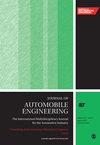Development and performance assessment of different squeal index metrics based on experimental data
IF 1.5
4区 工程技术
Q3 ENGINEERING, MECHANICAL
Proceedings of the Institution of Mechanical Engineers Part D-Journal of Automobile Engineering
Pub Date : 2024-04-22
DOI:10.1177/09544070241242827
引用次数: 0
Abstract
As an NVH problem observed in automotive brake systems, the significance of brake squeal phenomenon still persists; and the estimation of squeal propensity is a crucial operation. Thus, developing different means to define squeal propensity is an important task. As being one metric, squeal index is widely used for this purpose; and there already exists several different squeal index formulations in the available literature. The main objective of this study is to develop new squeal index formulations and assess their performances. Though, unlike the existing formulations, not only the measured data but also the operating and design parameters of the system of interest are also incorporated in the proposed formulations. The experimental data used for squeal index formulations are obtained on a mass-sliding belt experiment, where squeal-like behavior can successfully be observed. Experiments are conducted at different operating and design parameter conditions. First, cases with presence and absence of squeal-like behavior are observed on the measured data in time and frequency domains. Then, eight different squeal index formulations are developed, where different set of parameters are utilized in each formulation. Some of these parameters are extracted from the measured data (time and frequency domains), and the rest are adopted from the key operating and design parameters. Finally, the performances of proposed squeal indexes are assessed through their relative amplitude variations. In conclusion, the second squeal index formulation is found to have superior performance for distinguishing the effects of operating and design parameters on the occurrence of squeal-like behavior. Furthermore, the sixth squeal index formulation is found to have the best performance for differentiating the effect of spring stiffness on the initiation of squeal-like behavior.基于实验数据的不同尖叫指数指标的开发和性能评估
作为汽车制动系统中的一个 NVH 问题,制动尖叫现象的重要性依然存在,而尖叫倾向的估算则是一项至关重要的工作。因此,开发不同的方法来定义尖叫倾向是一项重要任务。尖叫指数作为一种指标被广泛用于此目的;现有文献中已有几种不同的尖叫指数公式。本研究的主要目的是开发新的尖叫指数公式并评估其性能。不过,与现有配方不同的是,所提议的配方中不仅包括测量数据,还包括相关系统的运行和设计参数。用于制定尖叫指数的实验数据是在质量滑动皮带实验中获得的,在该实验中可以成功观察到类似尖叫的行为。实验在不同的运行和设计参数条件下进行。首先,在时域和频域的测量数据上观察了是否存在类似尖叫的行为。然后,制定了八种不同的尖叫指数公式,每种公式都使用了不同的参数集。其中一些参数是从测量数据(时域和频域)中提取的,其余参数则是从关键运行和设计参数中采用的。最后,通过相对振幅变化来评估所提出的尖叫指数的性能。总之,第二种尖叫指数公式在区分运行参数和设计参数对发生尖叫行为的影响方面具有更优越的性能。此外,还发现第六种尖叫指数公式在区分弹簧刚度对尖叫行为发生的影响方面性能最佳。
本文章由计算机程序翻译,如有差异,请以英文原文为准。
求助全文
约1分钟内获得全文
求助全文
来源期刊

CiteScore
4.40
自引率
17.60%
发文量
263
审稿时长
3.5 months
期刊介绍:
The Journal of Automobile Engineering is an established, high quality multi-disciplinary journal which publishes the very best peer-reviewed science and engineering in the field.
 求助内容:
求助内容: 应助结果提醒方式:
应助结果提醒方式:


